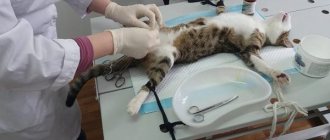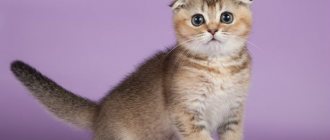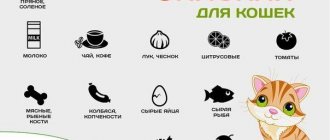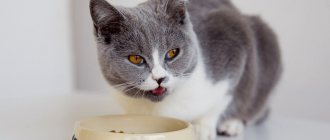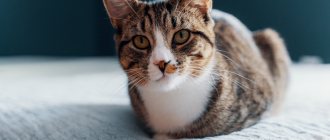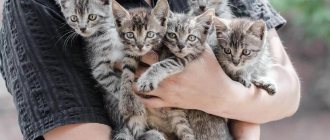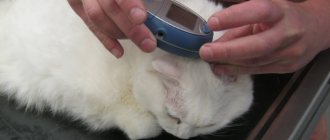If you have recently begun to think about castrating your four-legged pet, we recommend that you take this issue seriously. Neutering your Scottish cat will save you and him from many problems in the future. Seventy percent of animals that did not undergo this procedure suffer from prostate diseases, adenomas of the paranal glands and other diseases.
Hormonal drugs sold in veterinary pharmacies do not solve or completely prevent problems, and sometimes cause side effects.
Childbirth among Scots
Let's look at when and how labor begins in a Scottish Fold cat.
The first signs of labor in a cat are brownish vaginal discharge. The behavior of a cat often changes before giving birth: the animal is looking for a place (nest) to give birth, screaming and making attempts, especially if the Scottish female gives birth to kittens for the first time. In such a situation, it is worth staying close to the cat, calming it down and caressing it, and if necessary, helping, delivering the cat’s birth. Kittens are born head first.
Newborn kittens weigh about 100 grams and are a bubble filled with light yellow liquid. After the kittens are born, the mother chews this bladder, releases the cub and licks it to cleanse the lungs. You can help her with this by suctioning the fluid from her nose with an enema while the female gives birth to other kittens.
Kittens come out at intervals that last about 20 minutes, however, the cat can independently increase the duration of labor and delay the appearance of the babies and carry them for another day if something does not suit her or frightens her. After the young mother has been able to give birth to a kitten, the afterbirth comes out.
Kittens open their eyes a week after birth
All Scottish kittens are born with straight ears, and only at 3 weeks of age should you pay attention to the ears; in folds, they begin to droop
Advantages and disadvantages
The following facts will help the owner decide to undergo surgery for his pet.
- As already noted, sterilization and castration of cats significantly reduces the risk of developing serious pathologies of the genitourinary system.
- It has been proven that sterilized cats live longer than those that have given birth. The fact is that during childbirth the animal loses its health and strength, because a cat has to give birth several times a year, and the average life expectancy of Scottish Folds is 10–14 years. Sterilization can prolong a cat's life by 3-4 years.
- The risk of losing your pet is reduced. Now the animal that nature calls outside will not wait near the door for the right moment to escape. This is especially true for residents of upper floors. Often cats, in search of a partner, escape through windows and balconies, and this can be dangerous to their life and health.
- If a partner of a suitable breed is not found for a Scottish Fold pet, then you will have to breed the pet with a representative of unsuitable blood. This leads to offspring that have no value. It will be difficult to sell or give away kittens; outbred kittens often end up on the street. Sterilization will reduce the number of stray animals.
Before enrolling an animal in a veterinary clinic for castration or sterilization, it is worth considering some of the risks that this procedure carries.
- After surgery, animals, especially cats, begin to quickly gain weight due to hormonal reasons. Choosing food for a neutered cat requires a serious approach. To maintain the health of the animal, you have to buy expensive feed.
- During sterilization, the cat is given anesthesia. If the animal has heart problems, it may not tolerate the effects of anesthesia. Therefore, a full medical examination is required before the procedure.
- If an external suture is used during sterilization, the cat should be blanketed for the next few days. The owner needs to ensure that the pet does not get caught in the bandages, remove the blanket or lick the seams.
Special habits of the Scots
Scottish Fold
Description of the character of the Scottish Fold cat can be described by their characteristic habits:
- Interesting and even funny leisure habits. They sleep on their backs, which is not typical for cats in principle. This sleeping position is not observed in any other breed of cat.
- Observing something while standing on its hind legs if the object is high.
- To attract attention and receive its share of affection, it can purr and rub its muzzle against a person.
- Can't stand being held or being squeezed. The cat may show its displeasure.
- In pursuit of an object of interest to them, for example, when playing with a person, they run very fast and can climb onto a hill. They jump well, run and have well-developed muscles.
- Scottish cats are usually silent. They voice only in important situations, in their own opinion. If you come across a sociable individual, you need to understand that he will become too sociable. He will accompany with his comments every step of the owner and his own. Many people don't like this behavior. Therefore, it is worth taking a closer look at the animal’s character while still in the nursery.
How can you recognize the character and disposition of a kitten from childhood? All kittens, due to their age, are active and curious.
Any rustle in the apartment arouses their attention and interest. It’s difficult to see a small kitten doing nothing; they are constantly busy with something and find new things to do.
If there is no toy, it will be replaced by any object that comes into the animal’s field of vision. The toy can even be an object imagined in the kitten’s fantasy or a play partner.
But there are kids who prefer to sit on the sidelines and not participate in these races; they play with their brothers reluctantly and rarely. This behavior is considered normal for this breed. Such individuals are considered less active, cautious, and calm. Such kittens spend time alone, exploring the surrounding space in a measured manner. It has been noticed that such animals are more devoted to their owners.
The letter M on the forehead of a Scottish cat
Good nature and sociability
The Scottish Fold cat breed can be called a model of behavior. They are reserved, well-mannered, and are not inclined to impose their company on a person. But the breed has a pronounced good nature and good sociability. This applies to people and animals. They are not distinguished by vindictiveness, which is observed in other cat breeds. Conflict situations for fold-eared and straight-eared cats are a rare situation in which the cat showed protective measures in response to aggression towards him. If you offend a Scottish dog, he will prefer to hide rather than get into a fight. This is a last resort for them.
How to express your desires
Scots express their desire for something with a special purr, a voice that is characteristic only of this breed
They can rub their muzzle against a person, follow him, and try in every possible way to get attention. They exhibit this behavior in cases of hunger, the need to play, and other situations that they consider important.
Activity
The character of the Scottish Straight cat is phlegmatic. Their movements are measured and unhurried. They rarely run, especially in adulthood. If an adult cat is asked to run after a candy wrapper or a string with a piece of paper, the cat will express its bewilderment and surprise. The best pastime for them is to lie on their bed and take a nap.
Cleanliness
This breed is considered clean. They love to take care of themselves and maintain hygiene. They can spend hours licking their fur. Some owners say that sometimes this ritual is similar to mania, and a person’s touching them is regarded as an encroachment on his freedom. This character trait also applies to the toilet. They should always have a clean tray, but it is not typical for the animal to miss it. Going to other places to relieve yourself is a crime and an extreme rarity for the Scots.
At what age?
If the question of the operation can be considered resolved, it is very important not to miss the moment and do it on time. Now there are no strict limits on this, and in clinics where sterilization is routine, cats can be accepted from the age of three months
However, no one is saying that early intervention is impossible. But the consequences may not be entirely good. For lovers of purebred cats, their appearance is important.
If a Scottish cat is neutered too early, his body may grow disproportionately. Such defects will be especially visible when considering the size of the head relative to the body. It is impossible to correct this later.
Typically, cats are sterilized when their body has developed and become strong enough. In addition to cosmetic disadvantages, this makes it easier to endure the operation itself and to recover better after it. The optimal age is from 8 to 11 months. In addition, it is necessary to contact a veterinarian before the cat begins to mark its territory or at the first manifestations. It is believed that the earlier a Scot began to do this, the more likely it is that he will continue this at an older age. The percentage of such cases is small, but it exists. The same goes for cats - it’s better to do it before she has time to get to know the cat better.
Sometimes sterilization is necessary for adult animals, especially if there are health problems. But there are pitfalls here too.
The older the cat, the more health problems it has, which means the risk of possible complications increases.
What vaccinations are given to kittens, cost
Small, helpless kittens receive the first antibodies that increase immunity along with the mother's cat's milk. After weaning, instead of colostrum, the baby needs additional protection of the body from viruses and bacteria. At the age of 8-10 weeks, vaccinations are required for Scottish kittens. Before the first vaccinations are carried out, the kitten is prepared and the body is prevented from worms.
Depending on the conditions of detention and lifestyle, the first vaccination for a Scot contains:
- a vaccine against herpesvirus, calicivirus, panleukopenia and rabies, even if the animal leads a permanent home lifestyle;
- They also vaccinate against viral leukemia and chlamydia if the kitten lives in a private house, in a country house and leaves the house where it has likely contact with other animals;
Vaccinations for fold-eared kittens, as well as straight-eared Scots, are performed in accordance with the following scheme:
- At 2 months, the full range of vaccinations with the exception of the rabies vaccine;
- At 3 months, revaccination is carried out with the same complex of drugs with the addition of rabies vaccine.
- Every year and beyond, as the child grows, the entire vaccination package is repeated, including the anti-rabies drug.
The cost of vaccination depends on the price of the drug and factors of the procedure in different regions of the country and consists of:
- from the cost of the most common complex of drugs: Purevax RCPCh + Rabizin + Nobivac Rabies;
- prices for issuing a veterinary passport;
- payment for the work of a veterinarian;
- payment for calling a doctor to your home.
Adults (what vaccinations are given to adults + cost)
Vaccinations for adult cats and Scottish cats have the following advantages:
- they support the immunity of animals to environmental living conditions.
- Vaccinated pets develop a persistent, throughout the year, resistance to serious diseases;
- The vaccinated animal is protected itself and the owner is guaranteed protection, for example, from rabies;
- The occurrence of some infectious processes in a mild form
- When walking in nature and interacting with other animals, the risk of your pet contracting an infection is reduced to a minimum.
Throughout life, the vaccination procedure is repeated annually, preferably in the same month of the year. They make sure that the animal is dewormed on time, is healthy, and that the cat is not pregnant or nursing cubs.
The basic composition and cost are similar to vaccination for kittens, depending on the region and other factors.
Unusual names and nicknames
Fold-eared and straight-eared cats and female cats of the Scottish breed with their round faces and bright eyes look very funny and touching. Many people have a desire to give their pet a funny, unusual name:
- Suitable for Scottish cats: - Boomer; Little Crow; Dirty; Liman; Pepper; Chimney sweep; Dried apricots.
- For straight-eared cats choose: - Otter; Mustard; Devil; Ink; Chucha; Chang; Chernushka; Devil; Chimera.
- For the fold-eared cat and the cat that looks like an alien, they give cosmic names: Star; Space; Moon; Luntik; Neptune; Orbit; Uranus.
There is no rush to choose a name for a Scottish kitten; they carefully look at the pet’s appearance and character. How he walks, eats, plays with other kittens. Any touch helps determine the right choice. Before making a final decision, you should study the metrics of a Scottish kitten, read the recommendations of breeders, and read about the possible options for nicknames for each type of Scottish cat.
When is a Scottish cat neutered?
Veterinarians give clear advice at what age to castrate Scottish kittens - as soon as possible after birth, approximately 10-12 months. This is the optimal age for the operation, when the animal is considered sexually mature, hormones in the body have played a role in development, so there are no contraindications to castration of a Scottish fold cat. The main thing is that the cat is healthy and is examined by a veterinarian.
If a cat is neutered after the experience of mating with a cat, then he may retain the mating process, as well as intuitive memory and behavior.
A Scotsman can and should be castrated at any age, but preferably before the age of 5, when he does not have age-related diseases.
The cost of castration surgery varies depending on the region of the Russian Federation, as well as where it is performed. Calling a veterinarian to your home is convenient for the owner and the cat, but is complicated by special preparations for the site for surgical procedures.
Table No. 1 Approximate cost of castration of cats in different cities of the Russian Federation.
Why do they castrate?
Many people choose a Scottish fold or straight-eared kitten for the soul, because of their love for this breed of cat. Often, breeders themselves neuter pet-class kittens with slight deviations from the standard before sale. This is especially true for Scottish Folds, who are susceptible to genetic diseases due to improper mating.
Unsterilized cats, in the absence of mating, mark the space with stinking urine, during sexual behavior they loudly make terrible sounds and show aggression, which forces the owner to resort to castration surgery.
A conventional operation (orchiectomy), when the testicle in the scrotum needs to be removed, goes quickly. It only takes 15 minutes for the veterinarian to make one small incision, remove the testes, and return the pet to the owner.
Minor complications can arise when you need to castrate, and the kitten is diagnosed with cryptorchidism:
- the ovary-testis is not descended into the scrotum:
- the ovary-testis is located outside the scrotum;
- the ovary-testis is incorrectly located, under the skin in the groin or perineum.
In case of such deviations, the “cryptorchus” operation can be performed in the following ways:
The open method requires surgical intervention with an incision in the place where the ovary-testis is found:
- A more gentle intervention using a puncture, through which the doctor performs all manipulations to remove the ovary and testis.
- Scottish cats should not be fed 5 hours before the operation, because it is performed under anesthesia, and the animal may vomit.
Pet after castration
The entire postoperative period for both straight-eared and fold-eared kittens will last several days and pass without complications. The Scottish cat will need special care on the first day when he recovers from anesthesia:
- be sure to place a sanitary napkin under it; if it is weakened, it may not reach the tray;
- provide a warm place; after surgery, the cat’s internal heat exchange is disrupted;
- Do not place the cat in high places so that it does not fall;
- do not force him to eat, but place him next to a container of water.
After recovering from anesthesia, a well-rested pet will behave as usual
It is important to make sure that he does not lick the incision site. For this purpose, a postoperative collar is put on him.
The wound is treated with an antiseptic for several days.
Postoperative care
After the operation in the clinic, the Scottish cat is given to the owner, who is under anesthesia. To provide postoperative care you must:
- transport the animal in a comfortable carrier;
- do not transport an operated cat on public transport, where it can easily pick up an infection;
- at home, allow the pet to freely recover from anesthesia; its duration depends on the drug administered and the cat’s body;
- the cat is placed on the floor, on a warm bedding, which must be changed in time if the cat pees itself;
- If, during the operation, external stitches were placed on the cat’s wounds, then a blanket is put on so that the cat does not reach them with her tongue;
- After the operation, the Scottish woman is not given food. Just put a bowl of water next to it;
- for postoperative constipation, the cat is given a laxative, on the advice of a veterinarian;
- Many people do prescribed intramuscular injections with antibiotics themselves or take their pet to the clinic;
- Wounds are treated with antiseptics twice a day;
- The blanket is removed only after the wounds have completely healed.
Cat food (after surgery)
It is necessary to feed a castrated cat after surgery taking into account his new physiological state, which changes dramatically. He loses interest in cats, and an increased desire for food appears, which is promptly regulated:
- On the first day after the operation, the animal is not fed; it may vomit from the anesthesia; water is placed nearby.
- They think over a diet for natural feeding with an emphasis on protein, fermented milk, ground foods and vegetables.
- With ready-made food, first they give wet food, premium class, designed for neutered cats.
- They feed cats in small portions, do not leave food in bowls, dose the food, and protect the cat from obesity.
- If the kitten is overweight, fasting days are arranged for him.
Cat food (after surgery)
The sterilization operation is difficult for a Scottish cat to tolerate, especially in the first days, until the suture has healed. Subsequently, the cat’s nutrition and behavior will be affected by hormonal imbalances in the body, increased appetite will appear, and metabolism will deteriorate. The owner must follow the rules:
- On the first day after surgery, while the anesthesia is in effect, the cat is not given food. Make sure she drinks water, otherwise dehydration may occur.
- After the operation, to prevent the stitches from coming apart, the castrated cat is fed light pureed food, preventing constipation from occurring.
- Meals should be fractional, in small portions 5-6 times a day, gradually increasing the daily intake to 150 grams.
- A properly formulated diet should contain -35% protein, 35% carbohydrates and 30% fat.
- After the stitches have healed, you can switch to ready-made super-premium food, specially produced for sterilized cats.
- It is necessary to regularly monitor the weight of the Scottish woman; if she deviates from the norm, she is put on a diet.
Selection rules
To choose the right name, you need to get acquainted with the varieties of Scottish cats, how they differ, and the characteristics of each type:
- Scottish Straight, "Scottish Straight", is a short-haired cat with erect ears. They are wide and have pointed tips.
- Highland Straight, "long-haired straight-eared" with wide erect ears.
- The Scottish Fold is a short-haired cat with a special type of ears that are slightly curved inward and resemble a shell.
- Highland Fold is a “long-haired fold” with the same shape of ears, because of their long hair they are completely invisible.
A name is given to a pet once for the entire cat’s life and its choice is carefully chosen so that it is easy to pronounce for the owner and readily accepted by the cat itself. Breeders have developed explanations and basic recommendations on how to name a Scottish kitten for a boy and a girl. The name is given following generally accepted advice:
- Brevity, no more than 2-3 syllables in the name, for example: - Ba-gi-ra; Nu-sha; Ti-ma;
- Euphony, pleasant and easy to pronounce: Lolita (Lola); Penelope (Pepa).
- Memorability of the nickname by the cat itself and all family members, especially small children, for example: Gita; Zita; Natalie (Nata); Peach (Persian); Tata.
- In the nickname it is recommended that the sounds be Ch, Shch, Zh, Sh, Z and S; they are well perceived by the ears of cats and kittens: for example - Zhara Kisa; Gusto; Sonya; Weird guy.
- For Scots, when choosing a name, they additionally take into account:
- For long-haired Highland Straight, fluffy buns, the following is suitable: Chewbacca (furry, Star Wars character)
- For long-haired Highland Folds that look like owlets: Hedwig, that was the name of Harry Potter's owl.
- From external data, especially the muzzle and ears:
- For shorthaired Scottish Straights whose ears are always pricked up: Diana (goddess of the hunt).
- For long-haired Highland Folds, who look like aliens because of their folded, hidden ears: Sirius (constellation), Luntik (planet).
- Depending on the character, nicknames are suitable:
- affectionate: Marshmallow; Lapulya; Chupa Chups
- calm, intelligent: Darling; Mila; Umka (the quiet one from the cartoon).
- playful, nimble: Egoza; Twist (which spins all the time).
- The name dictated at first sight of the kitten.
- For high-breed individuals, the names of Scottish cats are chosen taking into account the names of their ancestors and on the advice of the breeder. Often it is already included in the metric. Owners of pets with complex pedigree names, which consist of several, can reach up to 25 characters, will have to call for example: Laina Magic of the East, the diminutive name Lana.
Choice by appearance
All types of Scottish cat breeds are clearly distinguishable in appearance and are recognizable by the shape of the auricle and the length of the coat. What the Scots have in common is that they are well-built animals with a strong body, a large, owl-like head, bright eyes, most often yellow, and powerful, wide paws. The coat color can be any. In lop-eared animals, diseases are genetically determined by nature: cardiovascular and musculoskeletal.
- Name based on coat color:
- cats: Apricot; Banana; Whiskas; Crow; Grace; Jacquard; Yolk; Lime; Peach; Rubin Uryuk.
- cats: Bagheera; Snow White; Goldie; Dove; Mustard; Toffee; Cinnamon; Turmeric; Lavender;
- By distinctive Scottish origin:
- Cats: Archibald (brave); Maynard (brave); Derek (king of the nation); Richard (brave); Clemens (gracious): Edgar; Edmund (names of the rulers of Scotland).
- Cats: Ariana (purity); Beatrice (traveller); Veronica (giving victory); Daria (symbol of wealth);
- Large kittens are usually called: Atlas (Atli); Grandis (Grand) Titans (Titus).
- Small-sized babies: Baby; Kroshka (Krokha); Slimy (Slim); Bambino (Baby).
- Choice by character. Each Scottish kitten, regardless of the shape of its ears, has its own individual, unique character. Gentle by nature, they will never offend even a bully child. The pet is given a name:
- Good-naturedly:
- cats: - Miron (Mirosha); Quiet (Tisha); Joy; (Joe); Gang; Sandria (Sani);
- cats: - Avilina (Eva); Adelaide (Ada); Barbariska (Barbie); Clare.
- For the mischievous, playful with an explosive temper: - Butuz (Butya); Clyde; Hurricane; Tyson (Tai); Skoda; Shuler (Shulya); Phantom (Phantom).
Features of preparation and care after
Both castration and sterilization are elective surgeries, so the animal must be examined by a doctor before setting a date. It is best to ask your veterinarian for all the information about upcoming procedures.
Particular attention should be paid to preparing for surgery. This Scotsman must be examined by a veterinarian to make sure he is healthy
Therefore, it is necessary to start small: rid him of fleas and parasites, get all the necessary vaccinations in advance (at least a month before the operation). Contraindications are diseases in the acute phase, as well as the cat’s estrus period. As for hygiene, everything is very simple.
It is advisable to trim the claws and wash the animal. But if a Scot doesn’t like to swim, this needs to be done at least a week in advance. This and other stressful situations should be eliminated in the coming days so that the cat feels calm.
And for the peace of mind of the owner, it is necessary to carefully choose a clinic and a doctor. The professionalism of the staff, reviews, location and the possibility of follow-up play a big role here.
Immediately on the day of surgery, the animal should not be given food, medications or supplements without the consent of the veterinarian. All procedures usually do not take more than an hour, after which the pet can be picked up. But since it is believed that Scots, like other purebred cats, react poorly to anesthesia, it is better to spend the next two to three hours in the clinic. Moreover, the pet may need help for several days, so it needs to be well looked after.
Immediate recovery from anesthesia can last up to a day. Therefore, during this period it is necessary to eliminate all dangers that the cat may encounter. It should not be placed on high surfaces for fear of falling, or left unattended near a container of water due to the risk of unconsciousness and drowning. To keep your cat from freezing, you need to wrap it up and monitor the temperature in the room.
The seams deserve special attention. Cats may need a blanket, depending on the complexity of the operation (removal of only the ovaries or along with the uterus). You can remove the blanket only after visiting the veterinarian again. In cats, stitches may not be needed during sterilization. But you need to make sure that it does not disturb the operation site. The condition of the seams can only be assessed by a specialist. He can also prescribe medications and give other recommendations that must be followed.
Food deserves special attention. In the first days, preference should be given to wet food so that constipation and other problems do not cause additional discomfort. Then you need to switch to special food.
The fact is that castrated Scots often gain weight due to a sedentary lifestyle. Therefore, their nutrition must be appropriate.
Why is the procedure needed?
Sterilization and castration are carried out to normalize hormonal levels in those pets whose sexual needs cannot be satisfied naturally. There are two types of indications for surgery: medical and behavioral.
An indication for surgery may be the behavior of the animal:
- the cat constantly marks the territory, after which a pungent smell of urine remains;
- the pet is aggressive, rushes at people;
- During estrus, the cat suffers, screams loudly, and cannot find a place for itself.
If it is not possible to regularly satisfy your pet’s sexual needs, then it is better to undergo surgery. After it, the animal will stop suffering from dissatisfaction and will become much calmer and more affectionate. After castration, cats stop marking, and their urine loses its pungent odor.
Medical indications are primarily related to the fact that hormonal imbalances can lead to many diseases in pets:
- Oncological diseases. Cats may develop cancer of the mammary glands, ovaries and other genital organs. In cats, prostate cancer comes to the fore.
- Pathology of the genitourinary system. This category includes urethritis, prostatitis and other inflammatory and infectious diseases. In addition, it has been scientifically proven that this surgical intervention increases the pet’s life expectancy.
- Stop marking the territory;
- Disappearance of the too strong smell of urine;
- Lack of desire to run away from home;
- Stopping aggressive behavior and maintaining a playful nature;
- Increased life expectancy;
- Prevention of prostatitis, prostate tumors, etc.
- Administration of anesthesia (intravenously, often intramuscularly);
- Preparation of the “operation field”;
- Making two or one small incisions in the skin of the scrotum;
- Ligation of the spermatic cords;
- Removal of testes;
- Treating the stump with antiseptics;
- Administration of standard medications (antibiotic, hemostatic).
The operation does not require stitches and is carried out very quickly. The entire procedure will take 15 minutes.
You can choose the option of castration, when the cat sleeps for 3-4 hours (classic option of castration). At the same time, the cat should not eat on this day, and water can be given only 5 hours after the doctor leaves.
There is a more pleasant option of castration, when the cat comes to his senses already in front of the doctor and even goes to accompany the doctor to the doorstep, controlling his body quite well (which is excluded in the classic version). In this option, you are allowed to eat after 2 hours and drink immediately.
If you wish, you can purchase a cat collar from the doctor, which can be worn for the first 2-3 days to prevent the cat from licking the wound.
Immediately after castration, the food does not change, and the cat eats as before, with its usual food. It is recommended to switch to castrated food 3-4 weeks after neutering. When feeding castrated cats, you should follow a special diet that excludes the consumption of fish dishes.
Preparing a Scottish cat for sterilization
When you register your cat for sterilization, you will be told about the preparations you will need to do at home. Usually, due to the fact that cats are sterilized under anesthesia, you will need to not feed the cat for several hours.
The second stage of preparation is done by a veterinarian in the clinic. This includes an examination, checking the heart, lungs, absence of infections and other health indicators. In some cases, examination and auscultation are enough for doctors to take the cat for surgery, but sometimes doubts arise and additional studies have to be done. If the cat is not young or has suffered from any chronic diseases or has undergone other operations - all this increases the risks, so additional research will most likely have to be done. If the cat is young, healthy and has never had any complaints, it is possible that no additional preparatory studies or tests will be necessary.
When can a Scottish Fold cat be neutered?
From the moment of puberty, the four-legged friend begins to mark everything in the house, becomes aggressive and suffers from the dissatisfaction of his needs. During this period, the owner of a Scottish Fold cat should consider castration or sterilization. This is especially true for those cats that do not go outside, but spend their lives at home. An operation performed at the wrong time can adversely affect the development of the cat.
Castration is a simple operation during which the testes are removed from a male animal. This procedure is performed under general anesthesia in any veterinary clinic. First, the animal is prepared for surgery, anesthesia is administered, then the site is prepared and the testicles are removed. After this, the cat is administered antibiotics and hemostatic agents and is brought out of anesthesia. As a result, the pet loses interest in mating forever.
The significant advantages of castration are:
- 1. The pet stops marking its territory.
- 2. The pungent smell of urine disappears.
- 3. The animal becomes less aggressive.
- 4. Life expectancy increases.
- 5. The risk of many diseases is reduced: prostatitis, prostate tumor and others.
Veterinarians recommend castrating a Scottish cat at the age of 10–12 months. During this period, the animal usually reaches puberty.
Some advise carrying out this procedure much earlier (at 6–8 months). This is absolutely impossible to do, since all organs have not formed by this age. Problems may also arise with the urethra. With early castration, he will remain underdeveloped.
Castration at a later stage will lead to the fact that the cat will continue to mark the territory even after the operation, if there has already been mating before.
Therefore, the question of castration of the fold depends on the time when full puberty occurs. This can be determined by the following signs:
- The smell of urine changes (becomes pungent).
- The pet becomes restless and behaves aggressively.
- Refuses to eat.
- Constantly meows and moves fussily around the house.
If these characteristics occur, you should immediately contact your veterinarian for surgery.
The genitourinary system of a Scottish Fold cat is formed by eight months. If the operation was performed earlier, then changes in it are possible, which ultimately leads to obstruction in the urethra. Due to an excess of microelements such as magnesium, phosphorus, and calcium in the body, stones form in the kidneys and bladder.
After the procedure to remove the testicles, the pet’s interests change: he does not scream, does not mark his territory, and spends most of his time calmly, lying on the sofa. Due to such a sedentary lifestyle, problems with excess weight of the pet may arise. In this case, it is worth either changing the diet of the ward, or switching him to special food for neutered cats. There is no need to reduce the number of meals.
After castration, the Scottish Fold cat behaves calmly and balanced, concentrating on his favorite toys and a variety of games. From this moment you can begin training.
Castration of a pet will relieve many unwanted problems, but you should remember that there is an optimal age for it. If everything is done in a timely manner and correctly, the fold-eared cat will be no different from its relatives. He will continue to lead a full life and please his owner.
https://koshkamurka.ru/885-chto-nado-znat-o-kastratsii-shotlandskih-kotov.htmlhttps://vplate.ru/koshki/shotlandskaya/kastraciya-sterilizaciya/https://kot-i-koshka. ru/v-kakom-vozraste-kastrirovat-kota-shotlandca/
What types of operations are there?
Now let's define the terms. In fact, the term “ sterilization ” is not always correct. Sterilization (oophorectomy) is the removal of only the ovaries, which has hardly been practiced in recent years. Castration (ovariohysterectomy) is the removal of the ovaries and uterus. But nevertheless, even many veterinarians use the term “sterilization”, meaning castration, because. clients are accustomed to this formulation. In this article, we also use these two words as synonyms for convenience.
There is another type of sterilization - tubal ligation (tubal occlusion) or removal of the uterus while preserving the ovaries (hysterectomy). After this procedure, the cat remains in heat, that is, she continues to attract males, but cannot conceive. With this approach, the cat continues to have empty heats, which will most likely result in an inflammatory or cancerous disease sooner or later. But nevertheless, occasionally owners perform this particular operation. Why? It is needed if there is a cat and a breeding cat living in the house, which does not mate every day to produce high-quality offspring, but there is a need for sexual intercourse. Then the cat living next to him, whose pregnancy is unwanted, has her tubes tied, as a result of which, during the breaks between participation in breeding matings, the cat can have sex with her without any consequences, and thus keeps himself in shape. In this case, the owners act in the interests of the cat, but to the detriment of the interests of the cat. In our opinion, this is inhumane, but here we are talking not about humanity, but about business.
Article continues after advertisement
In all other cases, veterinarians advise performing either oophorectomy (removal of the ovaries) or immediate ovariohysterectomy (removal of the ovaries and uterus). Many veterinary clinics have left only the second method in their price lists, because it is preferable: if only the ovaries are removed, the risk of developing cancer and inflammatory diseases of the uterus remains. Then the operation has to be done again, but with a greater likelihood of a negative outcome.
All of the above types of operations can be performed using two methods, which differ in the method of penetration into the abdominal cavity.
Laparoscopy is a surgical operation under general anesthesia, in which penetration into the abdominal cavity occurs through tiny incisions (usually 2-3 with a diameter of 3 to 10 mm each), introducing a special instrument with a camera into the incisions, which displays an image on the screen and allows operation without visual access of the doctor to the insides. This operation is considered minimally invasive, that is, low-traumatic, after it minimal treatment of the wound is required, a short postoperative period, there is no need to wear a blanket, and the sutures are made from self-absorbing threads. If you click on the photo, additional illustrations will open in a separate window.
Traditional abdominal surgery (laparotomy) is an operation with full visual access of the surgeon to all the internal organs of the cat, without any cameras or screens. It is more traumatic, as it involves one incision from 2 to 10 cm. After it, a long rehabilitation period (10-14 days) is required with stitches and wearing a blanket. This is the type of operation that is most often practiced and is considered a classic method. In contrast, laparoscopy is a newfangled, expensive method. If you click on the photo, additional illustrations will open in a separate window.
If you're not afraid of technical details, you can watch a training video for surgeons on how to perform surgery on a cat. It contains a lot of details that are unnecessary for the average person, but you will become familiar with the process in great detail.
Laparoscopy for cats began to be performed relatively recently, so this operation is not available in all clinics. And it costs several times more. In addition, it is not certain that your veterinarian has the necessary experience. Therefore, in conditions of limited choice in small towns, it is always better to opt for the operation that specific doctors in the veterinary clinic can perform masterfully.
What you need to know when breeding Scots for the first time
Cats
Readiness for the first mating is determined in cats not only when they reach sexual maturity. Considering its delicate characteristics, this breed may show signs of readiness to have offspring as early as 9-10 months, but mating during this period is strictly prohibited. During early pregnancy, a young female may develop serious diseases, and the offspring may even die during childbirth or be born with serious pathologies and abnormalities.
Having reached the age of one and a half years, the cat becomes completely ready for potential mating. The owner only needs to determine the moment of estrus and look for a partner for his cat. But it is necessary to find a truly worthy partner, since estrus in Scottish Straight cats lasts no more than 4-6 days.
Cats
As for Scottish Straight cats, when they reach sexual maturity, they can mate at absolutely any time. They are not at risk of diseases associated with reduced fertility or those that will interfere with their further normal development. Males who have reached the age of 10 months are considered an adult, ready for reproduction.
The peak of increased activity and greatest fertility occurs in males in the spring season. So, the cat begins to behave restlessly, aggressively, begins to call the cat or mark the territory with urine with a characteristic specific smell.
Best age for sterilization
The period of puberty in cats differs from other pets. Once a cat reaches 6-9 months of age, it is considered fully sexually mature and can bear viable offspring.
In some cat breeds, due to the characteristics of the body, puberty occurs slightly earlier - at the age of 4.5 - 6 months. This period is characterized by the active release of hormonal substances of the sexual type into the bloodstream - estrogens (produced by the ovaries). Under the influence of a specific hormone, a condition arises that the cat causes anxiety to its owner - it begins to scream heart-rendingly and demand a male, trying to escape from the house.
Depending on the breed and temperament of the animal, the period of increased activity ranges from 2-3 days to 2 weeks. The period is marked by the fact that all organs of the reproductive system are actively preparing for the normal process of conception and further gestation of attached embryos. If the cat does not happen, then the body begins to produce another hormone - progesterone, which is responsible for reducing heat.
Often, animal owners resort to using various tablets and drops that limit the release of hormones in the body, thereby preventing the onset of estrus. Subsequently, pathological conditions such as endometritis, pyometritis, cystic hyperplasia of the uterine walls, and cystic formations on the ovaries arise. You can protect your cat by promptly sterilizing it.
The best age for sterilization is before the first heat. This is the age when the kitten has already reached puberty, but the reproduction process has not yet started. In most cases, the average age at which it is better to sterilize is 6-9 months
It is important to remember that if a cat has already begun to come into heat, you must try to prevent conception.

